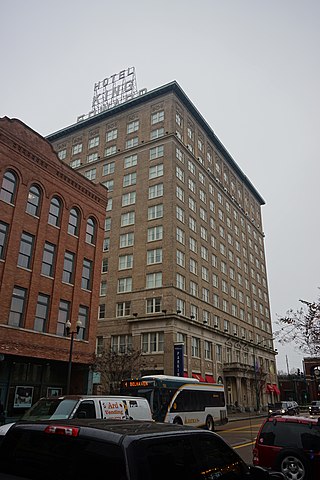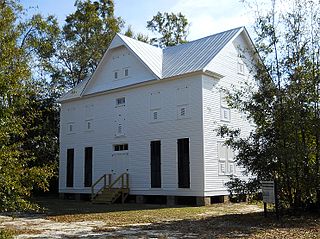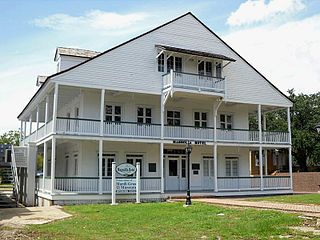
Windsor Ruins are in Claiborne County, Mississippi, United States, about 10 miles (16 km) southwest of Port Gibson near Alcorn State University. The ruins consist of 23 standing Corinthian columns of the largest antebellum Greek Revival mansion ever built in the state. The mansion stood from 1861 to 1890, when it was destroyed by fire. The 2.1-acre (0.85 ha) site with the columns was added to the National Register of Historic Places in 1971 and was designated a Mississippi Landmark in 1985.
Charles Henry Manship was a mayor of Jackson, Mississippi, during the American Civil War. He was also a chairmaker and ornamental painter.

Jefferson College, in Washington, Mississippi, at 16 Old North Street. Named in honor of Thomas Jefferson, the college was chartered in 1802, but did not begin operation until 1811. Jefferson College was founded as an all-male college but operated primarily as a college-preparatory school, and later became a military boarding school, which it remained for most of its history.

The King Edward Hotel, built in 1923 as the Edwards Hotel, is an historic hotel in downtown Jackson, Mississippi. The second of two buildings located on the site at the corner of Capitol and Mill Streets, it was closed and vacant for nearly 40 years before renovations began in 2006. The hotel was listed on the National Register of Historic Places in 1976, and declared a Mississippi Landmark in 1990. It was restored from 2007-2009 as a combination of apartments and the Hilton Garden Inn Jackson Downtown, which opened on December 17, 2009. It features the King Edward Grill, King Edward Bar, Pavilion Pantry convenience mart, a fitness center and formerly a Seattle's Best Coffee shop.

The Fisher Fine Arts Library was the primary library of the University of Pennsylvania from 1891 to 1962. The red sandstone, brick-and-terra-cotta Venetian Gothic giant—part fortress and part cathedral—was designed by the acclaimed Philadelphia architect Frank Furness (1839–1912).

The Old Mississippi State Capitol, also known as Old Capitol Museum or Old State Capitol, served as the Mississippi statehouse from 1839 until 1903. The old state capitol was added to the National Register of Historic Places in 1969. In 1986, the structure was designated a Mississippi Landmark and became a National Historic Landmark in 1990.

Merrehope, a 26-room Victorian mansion that currently serves as a historic house museum, was originally built in 1858 by Richard McLemore for his daughter Juriah Jackson. After changing ownership several times, with small alterations from each owner, the house was eventually bought by S.H. Floyd in 1904, who remodelled it into its present appearance. The building was one of few spared by General William Tecumseh Sherman on his raid of the city in the Battle of Meridian, and has served many functions throughout its history, including time as a residence, a shelter for Union officers, a Confederate General's headquarters, an apartment building, and a boarding house. The building was listed on the National Register of Historic Places in 1971 and as a Mississippi Landmark in 1995.
A Mississippi Landmark is a building officially nominated by the Mississippi Department of Archives and History and approved by each county's chancery clerk. The Mississippi Landmark designation is the highest form of recognition bestowed on properties by the state of Mississippi, and designated properties are protected from changes that may alter the property's historic character. Currently there are 890 designated landmarks in the state. Mississippi Landmarks are spread out between eighty-one of Mississippi's eighty-two counties; only Issaquena County has no such landmarks.

City Hall in Meridian, Mississippi in the United States is located at 601 24th Avenue. Originally designed by architect P.J. Krouse in 1915, the building underwent several renovations during the 1950s that diminished the historic quality of the building. City Hall was listed on the National Register of Historic Places in 1979 and as a Mississippi Landmark in 1988. After complaints of a faulty HVAC system, the building underwent a restoration to its original 1915 appearance beginning in September 2006. The project was originally estimated to cost $7–8 million and last two years. Because of several factors including the building's listings on historic registers, a lawsuit filed by a subcontractor, and unforeseen structural problems, the final cost and duration of the renovation far exceeded original estimates. The renovation was completed in January 2012 at a total cost projected to reach around $25 million after interest on debt.

Mississippi Department of Archives and History (MDAH) is a state agency founded in 1902. It is the official archive of the Mississippi Government.
The numerous historic hotels in Meridian, Mississippi, provide insights into the city's growth and expansion, both in the late 19th and early 20th centuries and into the modern age. Many hotels were built in downtown Meridian in the early 1900s to provide lodging for passengers of the railroad, which was essential to the city's growth at the turn of the 20th century. Two of these historic hotels–the Union Hotel, built in 1910, and the Lamar Hotel, built in 1927–have been listed on the National Register of Historic Places.

The W.J. Quarles House, also known as Greenvale, is a historic residence in Long Beach, Mississippi. Constructed in 1892, the structure was added to the National Register of Historic Places in 1980, and was designated a Mississippi Landmark in 2012.

The Magnolia Hotel was built in 1847 to serve as a lodging establishment. It is thought to be the oldest surviving hotel on the Mississippi Gulf Coast. The hotel was added to the National Register of Historic Places in 1973, and was designated a Mississippi Landmark in 1985.

Eureka School, located at 412 East 6th Street in Hattiesburg, Mississippi, was constructed in 1921 as a public school for African Americans. The school was the first brick school building for black students to be built in Mississippi. The former school building, which now houses a civil rights museum, was designated a Mississippi Landmark in 2005.

The Charnley-Norwood House is a summer (winter) cottage designed by architects Louis Sullivan and Frank Lloyd Wright in 1890 in Ocean Springs, Mississippi on the Mississippi Gulf Coast. The home was built as a vacation residence for James Charnley, a wealthy Chicago lumber baron, and its style represents an important change in American residential architecture known as Prairie School.

The Manse is a historic house in Natchez, Mississippi. It has been listed on the National Register of Historic Places since March 7, 1979.

Corinth Depot, also known as the Southern/GM&O Depot and now known as Corinth Crossroads Museum, was constructed circa 1917, and is located at 221 North Fillmore Street, in Corinth, Mississippi. The depot is a contributing property to the Downtown Corinth Historic District, which was placed on the National Register of Historic Places in 1993. In 1995, the depot was designated a Mississippi Landmark.

Magnolia station is a historic railway station located at 101 E. Railroad Avenue, in Magnolia, Mississippi. The depot was placed on the National Register of Historic Places in 1984 as The Depot and was designated a Mississippi Landmark in 2006.

Quitman Depot, also known as GM&O Railroad Depot, is a historic railway station located at 100 South Railroad Avenue in Quitman, Mississippi. The depot was placed on the National Register of Historic Places in 1994 and was designated a Mississippi Landmark in 1996.
The John M. Stone Cotton Mill is a building in Starkville, Mississippi listed on the National Register of Historic Places. Built in 1902, it was a cotton mill named for John Marshall Stone. It was renamed the E.E. Cooley Building after being purchased by Mississippi State University in 1965; afterward, the building was used for almost fifty years to house the university's physical plant. The building reopened in 2015 as an event center named The Mill at MSU.



![The Manship House in Recent Years [photo taken in 2019] The Manship House Museum.jpg](http://upload.wikimedia.org/wikipedia/commons/thumb/a/a0/The_Manship_House_Museum.jpg/619px-The_Manship_House_Museum.jpg)
















